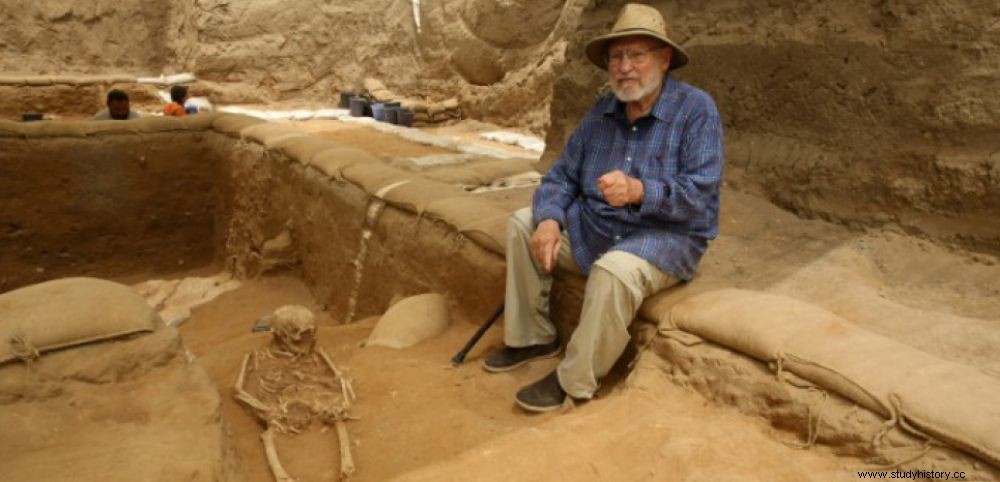 American archaeologist Lawrence E. Stager, professor at Harvard University, on the site of the first Philistine cemetery never found, in Ashkelon, Israel, June 28, 2016
American archaeologist Lawrence E. Stager, professor at Harvard University, on the site of the first Philistine cemetery never found, in Ashkelon, Israel, June 28, 2016 The biblical legend surrounding the Philistines, the people of the giant Goliath, is beginning to be shaken up by the discovery of bones in Ashkelon (southern Israel) in the first cemetery of this mysterious population that disappeared 2,600 years ago. Crouching in what was once a mortuary chamber, an American archaeologist, paintbrush in hand, delicately extracts from the sandy earth the intact skeleton of a Philistine woman, buried with a terracotta vial of perfume, now welded to the remains of his skull. "This is the culmination of years of excavations, the opportunity to come face to face with them" , enthuses archaeologist Daniel Master, from Harvard University, who is taking part in the excavations under the leadership of the Israel Antiquities Authority. "With 145 bodies discovered, we hope not only to understand their funeral rites, but to collect with their bones clues to understand how they lived" , he told AFP. It had been 30 years since various archaeological missions had hoped to uncover a cemetery in order to allow a first large-scale study of the Philistines. On the instructions of a retired Israel Antiquities Authority inspector, the first graves were discovered in 2013 on the site of the ancient Philistine port city of Ashkelon, with 13,000 inhabitants at its peak and on which today stands a natural park.
The Philistines, a people "deprived of their history"
Who were the Philistines? The origin of this "people of the sea" (name also given to their contemporaries on the shore of present-day Lebanon, the Phoenicians) is uncertain. Did they come - as evidenced by their red and black pottery - from the Mycenaean civilization, therefore from the Greek islands, where were they a local tribe from the desert or the mountains? "What is certain is that they were foreigners in this Semitic region" where their presence is attested on a thin coastal strip from present-day Gaza to Tel Aviv between 1,200 and 600 BC. JC, assures Daniel Master. The Philistines, proud traders and sailors, spoke a language of Indo-European origin, did not practice circumcision, ate pork and dogs, as evidenced by the bones found in the ruins of the four other neighboring Philistine cities (Gath, Gaza, Ashdod and Ekron) which constituted their state.
But the history of the Philistines was best known by the very negative image that their enemies and neighbors, the Israelites, made of them in the Bible. The Philistines are mentioned, from Genesis and especially in the book of Samuel which describes the capture by the Philistine warriors of the Jewish Ark of the Covenant and the famous duel between the giant Philistine warrior Goliath against David. From these biblical descriptions comes the adjective "philistine" denoting a person without manner or culture."We have been deprived of their history for millennia, but using what they left behind, not just the words of their enemies who described them as the worst people imaginable, we'll see what their remains have to tell us" , assures Mr. Master.
The excavations of the Ashkelon cemetery had been kept secret for three years
A few hundred meters from the pits, in the outdoor laboratory of the archaeological mission, Sherry Fox, an archaeologist specializing in the analysis of the remains, is responsible for making the bones speak. "From their teeth you can see that they had a hard life, there are lines that indicate growth interruption, probably starvation or severe fever during infancy, also seen in their bones that they were hard workers, that they practiced inbreeding and that they used their teeth as a tool, probably for weaving" , she explains, brandishing a skull. Sherry Fox, however, believes that they did not have "a particularly repulsive physique" , that they had a "normal size" and that no"giant" on the model of Goliath has been found. As for the question of whether there was a connection between the Philistines and the Palestinians, beyond mere sounding, the Harvard team has a clear answer. “Words are alike, but people are not. The city of Ashkelon was completely destroyed by Nebuchadnezzar in December 604 BC and the survivors were exiled to Babylon by the Persians. Everything that came after n has nothing to do with the Philistines" , assures Daniel Master. The excavations of the Ashkelon cemetery had been kept secret for three years, for fear of the reaction of ultra-Orthodox Jews who can demonstrate by the thousands when a cemetery is touched, because they fear possible desecrations of Jewish graves. The graves will be fully buried this summer and some of the finds from the yard were to be displayed at the Rockefeller Museum of History and Archeology in Jerusalem beginning July 10.
